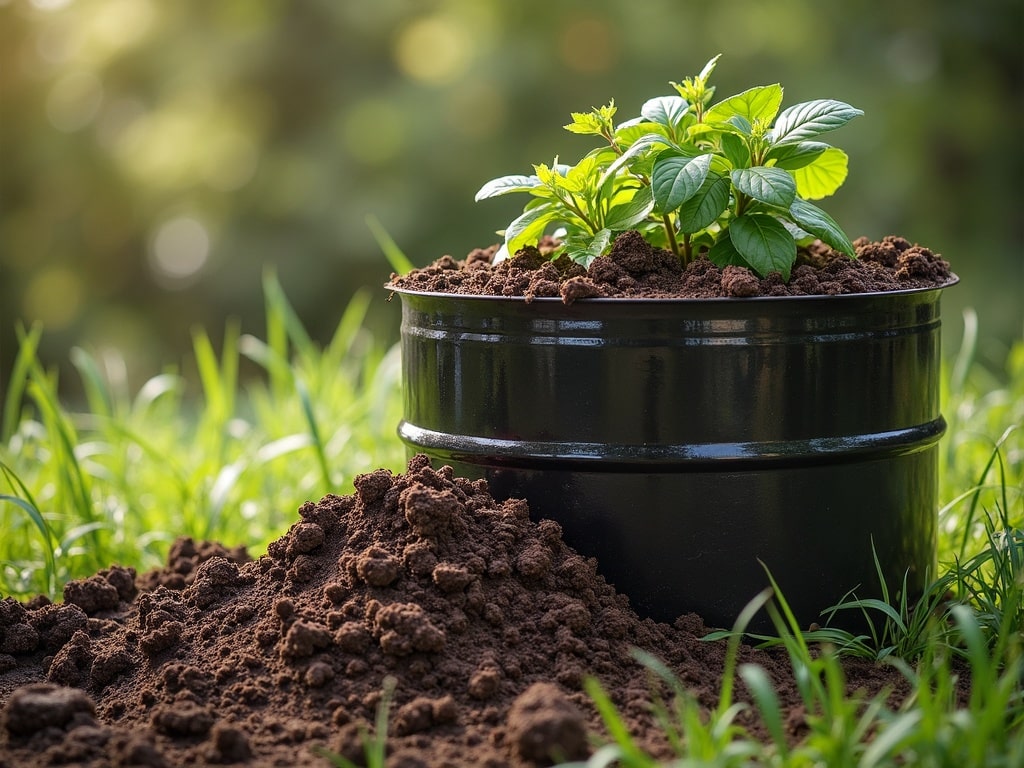Crafting Your Own Compost Sifter: A DIY Guide to Black Gold
Imagine turning kitchen scraps and yard waste into nutrient-rich black gold for your garden without breaking the bank. A compost sifter, often overlooked but incredibly valuable, helps you separate the finished compost from the unfinished materials, ensuring you're only using the finest, most beneficial compost on your plants. While commercially available sifters can be pricey, building your own is a surprisingly simple and rewarding DIY project. This guide will walk you through various methods for creating your own compost sifter DIY, tailored to different skill levels, budgets, and needs. Get ready to roll up your sleeves and unlock the full potential of your compost!
Why Build a Compost Sifter? The Benefits Unveiled
Before diving into the how-to, let's explore why building your own compost sifter is worth the effort. The advantages extend beyond just saving money:
- Cost-Effective: Store-bought sifters can range from $50 to hundreds of dollars. DIY options can cost as little as the price of scrap wood and some hardware cloth.
- Customization: Tailor the sifter's size, mesh size, and design to your specific needs and composting setup. Have a small balcony garden? Build a compact sifter. Processing large volumes of compost? Opt for a more robust design.
- Sustainability: Repurpose existing materials like old pallets, scrap wood, or even bicycle wheels, reducing waste and giving new life to discarded items.
- Improved Compost Quality: Sifting removes large, undecomposed pieces like twigs, eggshells, and persistent vegetable scraps. This ensures your plants receive a finer, more evenly distributed compost, leading to better nutrient absorption and healthier growth.
- Healthier Plants: By removing large chunks, you reduce the risk of introducing unwanted pests, weed seeds, and anaerobic pockets into your garden soil.
- Therapeutic & Educational: A DIY project is satisfying and educational. You'll gain a better understanding of composting and develop valuable construction skills. Think of it as hands-on learning in sustainability.
Choosing the Right Design: Matching Sifter to Your Needs
The beauty of a DIY compost sifter is its adaptability. Several designs cater to different needs and skill levels. Here's an overview of popular options:
The Basic Frame Sifter: Simplicity Defined
This is the simplest and most beginner-friendly design. It involves building a basic wooden frame and attaching hardware cloth to the bottom.
Materials:
- Four pieces of wood (e.g., 2x4s) for the frame. The length depends on your desired sifter size. A standard size might be 2ft x 3ft.
- Hardware cloth (typically ¼ inch or ½ inch mesh).
- Staple gun and staples.
- Screws or nails.
- Optional: Corner braces for added strength.
Construction:
- Cut the wood to the desired lengths.
- Assemble the frame by screwing or nailing the pieces together. Ensure the corners are square.
- (Optional) Attach corner braces for added strength.
- Cut the hardware cloth slightly larger than the frame.
- Stretch the hardware cloth tightly over the frame and secure it with staples using a staple gun. Start at one corner and work your way around, pulling the mesh taut.
- Trim any excess hardware cloth.
How to Use: Place the sifter over a wheelbarrow, garden bed, or container. Shovel compost onto the mesh and shake the sifter back and forth. The fine compost will fall through, leaving the larger debris behind.
The Tilting Sifter: Ergonomic Efficiency
A tilting sifter reduces strain on your back and arms by allowing you to rock the compost instead of lifting and shaking the entire sifter.
Materials:
- Materials for a basic frame sifter (as above).
- Two additional pieces of wood for the base/legs.
- Hinges (two or four, depending on preference).
- Screws.
Construction:
- Build a basic frame sifter as described above.
- Construct a simple base or set of legs using the additional pieces of wood. The height of the legs will determine the angle of the tilt.
- Attach the frame sifter to the base using hinges. Position the hinges so the sifter can tilt freely.
How to Use: Place the tilting sifter over your desired collection area. Load compost into the sifter. Gently rock the sifter back and forth, allowing the fine compost to fall through. The tilting action makes the process more efficient and less strenuous.
The Trommel Sifter: For the Ambitious Composter
A trommel sifter is a rotating drum sifter, ideal for processing large volumes of compost with minimal effort. This option requires more construction skill but offers the greatest efficiency.
Materials:
- Large barrel or drum (plastic or metal). A plastic 55-gallon drum works well.
- Hardware cloth (choose your desired mesh size).
- Wood or metal for the frame and supports.
- Wheels or casters (optional, for portability).
- Motor and belt (optional, for motorized rotation).
- Screws, bolts, and other hardware.
Construction:
- Cut out the ends of the barrel or drum.
- Cover the barrel with hardware cloth, securing it tightly with screws or rivets. Overlap the edges of the cloth for added strength.
- Build a frame to support the rotating drum. The frame should allow the drum to rotate freely.
- Attach wheels or casters to the frame for portability.
- (Optional) Add a motor and belt to automate the rotation. This requires careful planning and mechanical knowledge. Consider the drum's weight and the motor's power.
How to Use: Load compost into the trommel sifter. Rotate the drum (manually or with a motor). The fine compost will fall through the mesh, while the larger debris remains inside the drum. Angle the trommel slightly so the debris gradually moves towards the lower end and is discharged.
The Pallet Sifter: Repurposing for Sustainability
This method utilizes readily available and often free pallets, making it an eco-friendly and budget-conscious option.
Materials:
- Pallet(s) – choose untreated pallets for safety in your garden.
- Hardware Cloth
- Staple Gun and Staples
- Saw
- Safety Glasses & Gloves
Construction:
- Disassemble the Pallet: Carefully disassemble the pallet, salvaging the wood planks. Wear safety glasses and gloves to protect yourself from splinters and nails.
- Build a Frame: Use the salvaged planks to build a frame similar to the Basic Frame Sifter. You can customize the size to fit your needs.
- Attaching the Hardware Cloth: Secure the hardware cloth to the frame using a staple gun, ensuring it is taut and evenly distributed.
- Add support legs (Optional): Attach additional pallet pieces to the bottom of the frame to create legs, raising the sifter off the ground for easier use.
How to use: Much like the basic screen sifter, you will place the compost on top of the screen and shake until the fine compost has fallen through the hardware cloth.

Essential Materials: Gathering Your Supplies
Regardless of the design you choose, certain materials are essential for building a durable and effective compost sifter:
- Wood: Choose untreated lumber for safety and sustainability. Cedar or redwood are naturally rot-resistant options. Reclaimed wood or pallet wood are excellent choices for a budget-friendly and eco-conscious project.
- Hardware Cloth: This is the most critical component. Choose a mesh size appropriate for your needs. ¼ inch mesh is ideal for creating fine compost, while ½ inch mesh is suitable for general-purpose sifting. Consider the gauge (thickness) of the wire; a heavier gauge will be more durable.
- Fasteners: Screws are generally preferred over nails for their superior holding power. Choose screws appropriate for the thickness of the wood you are using. Use galvanized or stainless-steel screws for outdoor projects to prevent rust.
- Staples: A staple gun is essential for attaching the hardware cloth to the frame. Use heavy-duty staples for a secure hold.
- Tools: Basic woodworking tools are required, including a saw (hand saw, circular saw, or miter saw), drill, screwdriver, staple gun, measuring tape, and square. Safety glasses and gloves are essential for protecting yourself during the construction process.
Step-by-Step Instructions: Building Your Chosen Sifter
Let's delve into more detailed instructions for building a basic frame sifter, incorporating best practices for a long-lasting and effective result:
Detailed Instructions: Basic Frame Sifter
- Planning & Measuring: Determine the desired size of your sifter. A 2ft x 3ft frame is a good starting point. Cut the wood to the required lengths using a saw. Ensure all cuts are square for a tight-fitting frame.
- Assembling the Frame: Lay the four pieces of wood on a flat surface, forming a rectangle. Use a square to ensure the corners are 90 degrees. Apply wood glue to the joints for added strength. Secure the corners using screws or nails. Predrill the screw holes to prevent the wood from splitting.
- Reinforcing the Frame: (Optional) Attach corner braces to the inside corners of the frame for added strength. This is particularly important if you plan to sift heavy loads of compost.
- Preparing the Hardware Cloth: Cut the hardware cloth slightly larger than the frame. This will allow you to easily attach it to the frame. Wear gloves to protect your hands from the sharp edges of the wire mesh.
- Attaching the Hardware Cloth: Lay the hardware cloth over the frame, ensuring it is centered. Stretch the hardware cloth tightly over the frame and secure it with staples using a staple gun. Start at one corner and work your way around, pulling the mesh taut as you go. Space the staples about 1-2 inches apart.
- Trimming the Excess: Use wire cutters or tin snips to trim any excess hardware cloth around the edges of the frame. Be careful not to leave any sharp edges exposed.
- Sanding & Finishing: (Optional) Sand the frame to remove any splinters or rough edges. Apply a sealant or paint to protect the wood from the elements and prolong its lifespan. Choose a non-toxic sealant or paint that is safe for use in the garden.
Tips for Durability and Longevity
A well-built compost sifter should last for many years. Here are some tips for ensuring its durability:
- Use Quality Materials: Choose durable wood and heavy-gauge hardware cloth.
- Protect the Wood: Apply a sealant or paint to protect the wood from moisture and rot.
- Reinforce the Frame: Use corner braces or additional supports to strengthen the frame.
- Secure the Hardware Cloth: Use plenty of staples to securely attach the hardware cloth to the frame.
- Store Properly: Store the sifter in a dry place when not in use to prevent rot and rust.
- Regular Maintenance: Inspect the sifter regularly for any signs of damage or wear. Repair any damage promptly to prevent it from worsening.
Beyond the Basics: Advanced Sifter Modifications
Once you've mastered the basic sifter designs, you can explore more advanced modifications to further enhance its functionality and efficiency:
- Multiple Mesh Sizes: Create a sifter with multiple layers of different mesh sizes to separate compost into different grades. This allows you to tailor the compost to specific plant needs.
- Removable Mesh: Design a sifter with removable mesh inserts, allowing you to easily replace the mesh if it becomes damaged or if you want to use a different mesh size.
- Integrated Collection System: Add a chute or collection bin to the sifter to make it easier to collect the sifted compost.
- Motorized Sifting: Automate the sifting process by adding a motor to a tilting sifter or trommel sifter. This is ideal for processing large volumes of compost.
- Adjustable Tilt Angle: For tilting Sifters, Design a support system to easily adjust the angle without needing to rebuild the legs.
Troubleshooting: Common Issues and Solutions
Even with careful planning and execution, you may encounter some challenges while building or using your compost sifter. Here are some common issues and their solutions:
- Frame is not Square: If the frame is not square, the hardware cloth will not fit properly. Use a square to ensure the corners are 90 degrees during assembly.
- Hardware Cloth is Sagging: If the hardware cloth is sagging, it will not effectively sift the compost. Stretch the hardware cloth tightly over the frame and secure it with plenty of staples.
- Sifter is Too Heavy: If the sifter is too heavy, it will be difficult to lift and shake. Use lighter materials or build a smaller sifter.
- Compost is Clogging the Mesh: If the compost is clogging the mesh, it may be too wet or too chunky. Allow the compost to dry slightly before sifting and break up any large clumps.
- Sifter is Breaking: If the sifter is breaking, it may not be strong enough for the loads you are sifting. Reinforce the frame with corner braces or additional supports. Ensure the wood you are using to construct your sifter frame is not rotting.
Composting 101: Maximizing Your Black Gold Production
Building a compost sifter is only half the battle. To truly unlock the potential of your garden, you need to understand the fundamentals of composting. Here's a quick overview:
The Composting Recipe: Balancing Greens and Browns
Successful composting relies on a balanced mix of greens (nitrogen-rich materials) and browns (carbon-rich materials). Greens provide the moisture and nitrogen needed for decomposition, while browns provide the carbon that fuels the process.
- Greens: Include grass clippings, vegetable scraps, fruit peels, coffee grounds, and tea bags.
- Browns: Include leaves, shredded paper, cardboard, sawdust, and straw.
Aim for a ratio of approximately 2 parts browns to 1 part greens. This ratio provides the optimal balance of carbon and nitrogen for efficient decomposition. Keep in mind that this doesn't need to be exact science! A good rule of thumb is to add roughly twice the volume of browns as you add greens.
The Composting Process: Air, Moisture, and Microbes
Composting is a natural process driven by microorganisms that break down organic matter. These microorganisms need air, moisture, and a balanced diet of greens and browns to thrive.
- Air: Turning the compost pile regularly provides the necessary oxygen for the microorganisms. Aerobic composting is faster and less likely to produce foul odors than anaerobic composting (which occurs in the absence of oxygen).
- Moisture: The compost pile should be moist but not soggy. Aim for the consistency of a wrung-out sponge. Add water if the pile is too dry, and add more browns if it is too wet.
- Turning: Use a pitchfork or shovel to turn the compost pile every few days. This aerates the pile and helps to distribute moisture and microorganisms evenly.
Tips for Faster Composting
Patience is key but there are a few ways you can speed up the composting process.
- Chop or Shred Materials: Smaller pieces will decompose faster. Use a lawnmower to shred leaves or a food processor to chop vegetable scraps.
- Maintain the Right Moisture Level: Keep the pile moist but not soggy.
- Aerate Regularly: Turn the pile frequently to provide oxygen to the microorganisms.
- Use a Compost Starter: Add a compost starter to introduce beneficial microorganisms to the pile.
- Insulate the Pile: In cold weather, insulate the pile with straw or leaves to maintain a warm temperature.
Using Your Compost: Enriching Your Garden
Once your compost is ready, it's time to put it to use in your garden. Compost can be used in a variety of ways to improve soil health and plant growth:
- Soil Amendment: Mix compost into the soil before planting to improve its structure, drainage, and nutrient content.
- Mulch: Apply compost as a mulch around plants to suppress weeds, retain moisture, and regulate soil temperature.
- Top Dressing: Sprinkle compost around established plants to provide a slow-release source of nutrients.
- Potting Mix: Use compost as a component of your potting mix for container gardening.
- Compost Tea: Brew compost tea by steeping compost in water. Use the tea to water plants, providing them with a boost of nutrients.
By building your own compost sifter DIY and mastering the art of composting, you can create a sustainable and thriving garden, reduce waste, and save money. So, gather your materials, choose a design, and get ready to transform your kitchen scraps and yard waste into valuable black gold for your plants!
Additional Resources
For more information on composting and building compost sifters, check out these resources:
- Local gardening clubs and extension offices
- Online gardening forums and communities
- Books and articles on composting

